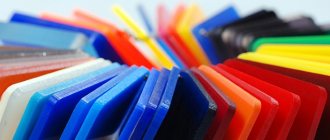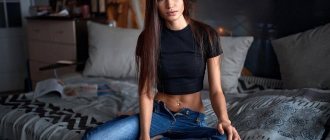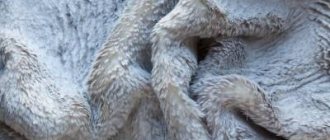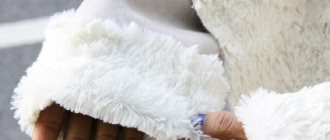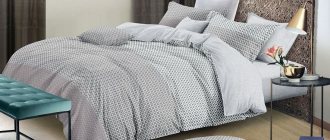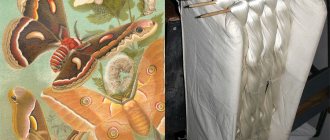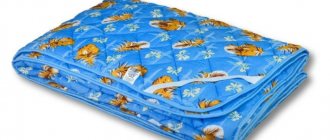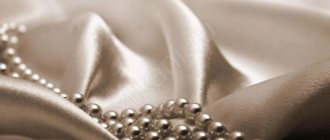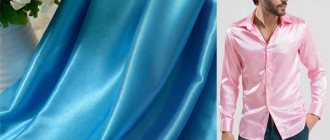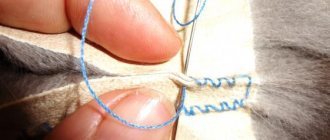Artificial fur
- textile material imitating
natural animal fur. Widely used in the manufacture of clothing, hats, soft toys and other products. It consists of a load-bearing base (soil) and a pile cover. Artificial materials that imitate natural ones are becoming increasingly popular every year. They attract with their comparatively lower cost, environmental friendliness and no less aesthetics. Modern faux fur can feel and look virtually identical to natural fur, and can be painted in bold, unexpected colors if used to decorate shoes. The advantage of faux furs over natural ones is the lightness of the products, ease of care and storage, less susceptibility to damage and, of course, lower cost. But there is also an important drawback that should be remembered: if natural fur allows the legs to “breathe” and protects them from freezing, then artificial fur is more likely to cause increased sweating.
Faux fur is very similar in appearance and properties to natural fur. As a rule, it consists of various types of fibers: wool or hair. They are applied to fabric (fabric, leather , cardboard) using an adhesive or weave. Thus, the material has a base and a fleecy cover. Faux fur is resistant to light, winter clothes are often made from it, and it is very pleasant to the touch. In terms of quality, color, and texture, it is almost as good as an animal.
Varieties and methods of obtaining
All types of faux fur fabrics consist of two layers - pile and base. The base can be cotton, wool, synthetic or mixed materials, as well as leather substitutes. Currently, acrylic is most often used for pile, which in its properties is close to wool . In addition, polyester, nylon (nylon), natural wool and mixed fibers are also used. The main difference between fur material is the method of its manufacture, according to which the pile fabric is distinguished as:
- Knitted fabric, which is produced on knitting machines by knitting bundles or loops of pile threads into a base of loops.
- Woven (two-layer) using three threads - weft, warp and pile. This results in a two-layer structure, where two layers of fabric are connected to each other by broaches of pile threads, which are then cut.
- Tufted or fabric stitched. To form it, the base is stitched with a pile thread, which is then cut.
- Adhesive, created by gluing pile onto the base material.
The glue method is considered one of the least reliable.
For fur fabrics obtained using the first three methods, the base is usually processed in order to secure the pile. Subsequent processing of fur comes down to cutting (smooth and textured), coloring (layer-by-layer, airbrush, stencil), heat treatment, as a result of which the threads acquire a different structure that imitates the spine and down of natural fur. This is interesting: Canvas fabric: description, linen, thick, other types
Differences from natural fur
Positive
- Does not require killing animals to obtain it.
- Has a lower cost.
- Faux fur is a textile material, so it is easier to sew.
- Faux fur materials made from chemical fibers are not eaten by moths.
- Lighter in weight.
Negative
- More breathable, so it retains heat less well.
- Shrinks during long-term storage. During use, the fur becomes matted and pilled ("pellets" are formed).
About the properties of fur.
Properties of faux fur: high abrasion resistance, wear resistance, good heat-protective qualities, lightness. This fur also has high breathability, is resistant to microorganisms, and most importantly has an affordable price. In addition, this material has good resistance to moisture and light. However, this type of fur has its drawbacks. For example, the fleecy part of the fur can become very wrinkled and roll into balls or tufts.
Methods for producing artificial fur affect its basic properties. Thus, fur with a knitted base has better thermal insulation properties compared to fur produced by the adhesive method. The disadvantages of artificial fur include such a property as high elongation at break, leading to changes in some components of the product. As a result of long-term storage and transportation, faux fur can change its linear dimensions; this occurs due to the fact that relaxation processes take place in both the canvas and the latex coating.
pros
- If you wear faux fur, you don't feel guilty about killing animals. And even if you have a lot of different fur products in your wardrobe, your conscience is completely clear.
- Another advantage of such fur is an important feature in our time - price. The use of synthetic fibers allows you to spend less on production - therefore, the price of such products is much lower than for fur coats made from natural fur.
- The production of artificial fur nowadays is at a very high level, so its quality is not inferior to natural fur. The products do not require special storage or special care, they are easy to clean, they cannot be damaged by moths, and they can remain shiny and beautiful for a long time.
- Artificial pile can be of any length and color, and even the most daring color schemes look quite authentic, while natural fur does not tolerate experimentation; its coloring significantly reduces the quality of the product and negatively affects its appearance.
Tips for buying a mink fur coat
We go into a fur store, see the beauty around us, take everything we have enough money for, and only at home, having moved away from the state of rainbow delight from the purchase, we notice all the defects. If you are familiar with this picture, then use the following tips to avoid becoming a victim of unscrupulous fur product manufacturers.
- Pay attention to the villi: if the product is natural and there is an air layer in it, then they should be elastic. This is evidence of a warm, quality item.
- When purchasing a dyed fur coat, be sure to check the color fastness.
- Remember the rule: the fewer seams, the more durable and high-quality the product.
- Evaluate the fur: it should shine and shimmer, this is the only way you will understand that it has been processed correctly.
- Look at the inside of the skin - there should be no cracks or other defects on it.
Without exception, all types of mink fur used for fur coats require high-quality care in order to maintain an aesthetic appearance for many decades. Fur coats should be stored away from sunlight, at room temperature, on hangers.
To clean, use a dry sponge and brush, do not forget to do this before putting the fur coat in the closet. It is not recommended to use pockets frequently or carry the product on the shoulder. If you follow just a few tips, your item will be in perfect condition for many decades, not only protecting you from the cold, but also pleasing the eye with its chic appearance.
Description
Faux fur consists of a ground on a woven, knitted, or artificial leather base, to which a pile of chemical or natural textile fibers, including fibers of animal origin, such as sheep's wool, is attached in various ways.
The pile can be plain-dyed (single-color), melange (multi-color) with printed patterns, including those imitating the natural color of the fur of various animals. Also, fur finishing may include curling or embossing. The pile is trimmed to the required length.
Story
Faux fur first appeared in 1929. At that time, it could not be considered truly artificial, since alpaca wool . The color of the fur left much to be desired, usually gray or brown, it was not at all like natural and was very short-lived. Completely artificial fur , consisting of 100% synthetic fibers, was created only in the 50s. Such fur was usually made of acrylic polymer, that is, it was essentially plastic. Somewhat later faux fur became a very popular material, firstly, it was possible to make fur of any color and shade, and secondly, its very affordable price was captivating.
Compound
To obtain artificial fur, polyester, polyamide, and acetate are used. This is a synthetic raw material for lint. Nylon and acrylic are also suitable for obtaining a pile coating. As an alternative to 100% synthetics, viscose and lyocell are processed. The material can be made from natural wool with a cotton base. This is the warmest and most expensive variety. At its core, it is close to natural material, since it has an environmentally friendly composition, provides excellent warmth, and does not contain glues or petroleum products.
How is artificial fur made industrially? First, the pile is produced, and then it is attached to the base. Natural fabric is used together with wool fibers. Synthetic pile is placed on artificial fabric.
Minuses
- Faux fur is less environmentally friendly. For its production, acrylic and polyacrylic polymers are used, which contain water, coal, limestone and petroleum products. The pile of such products is much stronger than natural, which means that it biodecomposes much longer.
- Another disadvantage may be the reduced frost resistance of artificial fur. Therefore, it is not suitable for extreme weather conditions. However, scientists and designers are working to improve its qualities.
- The external differences between artificial and natural fur are practically invisible, but to the touch natural fur is much softer and more delicate than any artificial fur.
Of course, if you are a lover of natural fur, no one will sprinkle flour or paint on you on the streets - this is the privilege of the stars. However, when buying a fur coat made of natural pile, you should not choose the “Ussuri tiger” or other rare animals, let them live a little longer on our planet. Well, the more people use artificial fur, the more its quality will increase. So who knows which material will be more popular in the future?
Don't want to see ads? log in
This is interesting: Printed fabric - what is it. Types with drawings, photos
Advantages and disadvantages
It is used for sewing outerwear.
Technologies for the production of modern textiles make it possible to bring synthetic and natural materials as close as possible in their properties. It is very difficult for a consumer who does not have special skills and experience to distinguish high-quality faux fur from its natural counterpart. The type of raw material, manufacturing method and additional processing provide the advantages of the material:
- The low cost of the material is its undeniable advantage, as it makes faux fur products affordable for people with low incomes.
- This material is much easier to care for than natural ones. It can be washed and cleaned with a vacuum cleaner, besides, you should not be afraid of the appearance of moths and harmful microorganisms; they simply are not found in synthetics.
- Faux fur fabric has a textile base, so it is easy to cut and sew products from it. In addition, the dimensions of the canvas allow the item to be made from a single piece of material, and not from individual skins, as when working with natural fur.
- Artificial pile can have the most incredible colors, and this only improves the appearance, while such experiments with natural material significantly reduce the quality of the product.
- The production of faux fur fabric does not harm the environment, since no one has to take the life of animals for the sake of a hat or fur coat.
The material has several disadvantages.
- The high breathability of faux fur reduces the thermal insulation properties of the fabric. Natural products are much warmer than artificial materials.
- Low wear resistance.
- Synthetic fibers quickly accumulate static electricity and attract dust.
Flaws
It is believed that a product made of synthetic pile provides worse heat. Indeed, such material is difficult to wear on your own. If we are talking about sewing winter clothes, then insulation is required under the fur fabric. Usually they use Thinsulate, which warms well but is thin.
If you do not care for the product correctly, it will roll up and shrink. Synthetic varieties are prone to electrification.
The disadvantages of the material also include its origin. Since most varieties of synthetic fur are made from petroleum products, they have a longer decomposition period. If we compare the harm from the disposal of artificial fur coats, it turns out that nature suffers no less than from the death of fur-bearing animals raised for their skins.
Features and characteristics of faux fur
Man-made fur material can be obtained from various raw materials and using different technologies, but its structure is always the same. It consists of two layers - a smooth base and fluffy pile. The base can be woven or non-woven material made from:
- cotton;
- synthetics;
- wool;
- mixed fibers.
The pile is most often formed from thin synthetic threads (acrylic, polyester, polyamide), less often natural wool. The connection of pile and base can be done using different methods. The simplest and least reliable of them is adhesive, which is now rarely used. More reliable is the molding of fur in the process of creating the main fabric, which can be:
- woven, in which, in addition to the warp and weft threads, a third one is also used, forming villi;
- knitted, when long loops or bundles of pile fibers are knitted into the warp loops;
- thread-stitched or tufted, stitched with pile thread.
After the fur fabric is produced, the base is processed to secure the fibers, and then they are cut, including at unequal heights, and dyed to imitate natural fur or create original color effects. For this, various stencils, airbrushing, layer-by-layer painting and other complex methods are used. To imitate natural curls and form a heterogeneous structure of the pile, it is heat treated.
Modern technologies for the production of artificial fur have reached such perfection that it is very difficult to visually establish the difference between natural and man-made material . However, their characteristics will certainly differ. First of all, artificial pile retains heat much worse than natural pile, so fur coats and hats made from it are not suitable for harsh winters. In addition, synthetic threads are hard to the touch, they become electrified and attract solid particles that pollute them, and wear out much faster than their natural counterparts. At the same time, fur fabric has many advantages, namely:
- uniformity of texture and ease of cutting;
- variety of types and colors, including creative ones;
- low cost;
- Moth resistance;
- easy to use and maintain;
- symbolizes the protection of nature and humanity towards the animal world.
Style Natural or faux: Which fur is more ethical and environmentally friendly
Today, replacing natural fur can be easily done. There are a lot of alternative technologies: if we talk about artificial insulation, then these are holofiber, Thinsulate, Holofil, Shelter, Fibertek, Isosoft (mostly these insulations are made from recycled polyester and can be reused; here is the production diagram for Thinsulate. - Ed.) . If we talk about substitutes based on plant fibers, then these are flax, jute, coconut and banana fiber, bamboo, eucalyptus, soy (all of the above materials are considered environmentally friendly; more about flax and banana fiber. - Ed.). These insulation materials can withstand temperatures down to minus thirty degrees.
They say that fur is natural, that our ancestors wore it in ancient times. But you and I don’t live in the Paleolithic! Isn't it strange, given our level of technical and social progress, to return to it today? There is also an opinion that in Russia you cannot survive in winter without a fur coat. You will be surprised, but low temperatures do not allow you to wear fur coats: severe frost simply destroys natural fur. Once we went to the White Sea with a team from the Ministry of Emergency Situations, and none of them even thought of going there in a fur coat. And in the Arctic, the fur instantly swells and becomes damp.
Natural fur definitely cannot be called eco-friendly. Advertising standards committees in England, Holland, Italy and other European countries have ruled that any advertising claiming that fur is environmentally friendly is misleading to consumers. A recent example is the ban on promotional fur in the UK, in which fur manufacturers argued that wearing it means being “eco-friendly”. How does fur harm nature? To answer this question, the Italian Anti-Vivisection League LAV commissioned a study. Its meaning is the analysis and comparison of the production of animal fur and other materials, their impact on the environment. The results show that producing one kilogram of real fur has the worst impact on 17 of 18 environmental indicators, including climate change, toxic emissions and many others. Fur is more harmful than cotton, acrylic, wool and even polyester with values two or even 28 times higher in production stages where these values were previously considered low. The only exception is water consumption, in which case cotton has the highest rate.
Fur farms themselves cause enormous harm to nature: the fur complex in Kresty in 2002 became one of the dirtiest industries in the Moscow region. Animal waste products concentrated in a small area pollute the environment, seep into the soil and poison water bodies. And, of course, we must not forget the cruelty of these farms: in Russia they still use leg traps, which lead to a long and painful death. On our fur farms, the main method of killing is curare-like drugs, which lead to slow suffocation (curare-like drugs are not recommended for euthanizing animals, since today there are more humane methods. - Ed.).
Fans of mink coats claim that the fur easily decomposes - this is true. However, in order to obtain this very fur, you need chemicals that are not at all environmentally friendly - otherwise your fur coat would simply rot in a matter of weeks. Mineral salts, formaldehyde, formaldehyde, coal tar derivatives, cyanide-based oils and paints, caustic soda - all this poisons the surrounding nature no less. By eliminating animal products, we are reducing our already enormous environmental impact—something we should all strive for.
Types and methods of production
The name of a particular type of material is determined by the variety of the original that it imitates: it can be artificial mink, astrakhan fur, arctic fox, etc. The structure of artificial fur is similar to natural fur and consists of a base (soil) and pile. The ground is mainly made from cotton yarn, but sometimes, for strength, synthetic fibers are woven into it. To increase the wear resistance of the fabric and better fix the pile, its reverse side is glued with foam rubber, latex and sizing - a substance that contains fats, starch, cellulose ethers, etc.
Fur can be made from both synthetic fibers - polyester, acetate, nitron, etc., and natural fibers - cotton and wool. The most valued are wool and cotton fabrics, which most accurately imitate real fur. Pile is often made from several types of fibers, including those with varying degrees of shrinkage. This makes the artificial material even more similar to natural.
To protect the fur from moisture, fading and creasing, it is treated with hydrophobic impregnations and special salts, polished with ethyl, etc. To give the most natural appearance, the pile is subjected to repeated combing, cutting, dyeing, etc. Through special heat treatment, the length and structure of the pile changes , due to which “guard hair” and “undercoat” are formed.
Depending on how the fur fabric is made, there are the following varieties:
- Knitted. In this case, tufts of pile are woven into the base using a special machine. The fur is securely fixed in the ground, but for greater reliability the underside is covered with film.
- Woven. By intertwining the warp, weft and pile threads, two fabrics are made, connected by pile. Next, the cloth is cut in the middle, and two pieces of fur with the same length of pile are obtained from it. To prevent the fibers from falling out, the soil is glued with a special compound. Woven faux fur is more lush and dense than other types of fur, reminiscent of natural fur.
- Tufted. This type of fur is also called fabric-stitched fur and is made by a buttonhole machine by stitching the pile through the base. In this case, loops are formed on one of the sides, which, after cutting, straightening and combing, turn into fur.
- Glue. This method is the most labor-intensive and involves gluing chenille (twisted pieces of cotton fibers strung on a nylon or viscose thread) to the ground. To ensure a tight fit, the fibers are placed by electrifying them. This fabric is characterized by the least wear resistance, but also the greatest similarity to natural fur.
Kinds
Widespread are woven and knitted long-pile artificial furs that imitate expensive natural furs of mink, marten, raccoon, muskrat, monkey and even fox, as well as smooth-pile furs - foal , calf, seal, etc.
- Woven faux fur is produced on looms using a pile weave
of three thread systems: warp, weft, and pile-forming thread. To secure the pile, a film coating, for example latex, can be applied to the underside of the primer. - Knitted faux fur - knitted on flat and circular knitting machines by knitting tufts of pile into the base of the loops of the knitted fabric. To secure the pile, a film coating can be applied to the underside of the primer.
- Fabric-stitched ( tufted
)
faux fur is made on tufting machines that form loops of pile on the front side of the fabric, knitwear or non-woven material, which are then cut and combed. To secure the pile, a film coating can be applied to the underside of the primer. - Overlay ( glue ) faux fur - a specially curled chenille
is attached to the fabric (calico or calico) with polyisobutylene glue.
Woven fur is formed by three systems of threads - pile, root and weft. In this case, two ground sheets are connected with pile threads, which are then cut. In the knitting method, the pile is knitted on special circular knitting machines.
Woven faux fur is produced on looms using a two-sheet, or less often rod, method. When producing artificial fur using the double-layer method, two systems of threads (warp and weft) are used to create the ground and the pile warp thread. When the weaving machine operates, two independent fabrics are formed, united by a pile base. When coming off the loom, the fur is cut with special knives into two pieces of faux fur.
When producing artificial fur using the rod method, one system of warp and weft and pile threads are used. When producing fur, rods are thrown into the shed. The threads, bending around the rod, create loops, which are cut when the rod moves back. After combing, these threads form a pile.
Woven fur is produced with a pile height of 4-22 mm, surface density 300-600 g/m2. Faux fur is used for the production of outerwear, toys, linings for clothes and shoes, collars, furniture upholstery, workwear, etc.
With stitching and gluing methods, the load-bearing base and pile are made separately. The pile is secured to the supporting base by stitching or gluing. Using the adhesive method, for example, artificial astrakhan is obtained. When producing artificial fur using the electrostatic method, fibers charged in an electrostatic field and then oriented are distributed evenly over the surface of the fabric pre-treated with glue, on which they are fixed after drying, forming a pile. Faux fur is produced with any density of pile cover. The latter is more uniform in height and distribution than natural fur hair.
Faux fur with applied or glued pile is produced by gluing pile threads (chenille - from the French “caterpillar”) to the surface of the fabric. To produce fur using the glue method, cotton fabric (calico), special pile threads (chenille) and glue are used as a primer.
Chenille is a yarn consisting of two twisted core cotton threads, between which a surge thread (nylon, viscose, lavsan, etc.) is fixed in the form of segments of a certain length (10-22 mm). Before producing artificial fur, chenille is curled on a curling machine, where in special tubes at high temperatures (210 ° C for nylon threads and 280-300 ° C for viscose threads), the chenille receives a crimped shape, which is stabilized at the same temperature.
In appearance, artificial fur almost completely reproduces the color, pattern and arrangement of the pile of simulated fur. To form the pile cover of artificial fur, various monofilaments or complex polyamide and polyester viscose and acetate threads are used. For long-pile fur, the most commonly used yarn is made from polyacrylonitrile fibers, which, due to their wooliness, low density, high elasticity, low thermal conductivity and very low hygroscopicity, are especially suitable for the manufacture of artificial fur. For the base (ground) of artificial fur, cotton yarn is used, sometimes for the purpose of strengthening - synthetic threads. Artificial fur is produced in various colors and patterns. Subsequent finishing of artificial fur ensures the resistance of the pile cover to creasing, fluffiness, hydrophobicity, and the creation of one or another patterned or embossed pattern through mechanical, thermal and chemical treatments. Depending on the texture of the simulated fur, finishing includes the following basic processes: repeated combing, cutting - trimming the pile, dyeing, heat treatment, polishing, patterned coloring of the pile, etc. To give the underside of the fabric the appearance of leather and firmly fix the pile to the base, sizing with latexes and finishing agents, duplication with foam rubber.
In appearance, color design and degree of imitation of hair, faux fur can be more or less close to natural fur.
Plush knitted fur is produced on machines where, simultaneously with knitting ground loops, plush loops are formed from complex and synthetic threads. The loops are then cut and combed. From them the faux fur pile is formed. To better secure the fur pile, the soil is covered on the reverse side with a thin layer of latex film, which gives it good water resistance.
The pile is subjected to various finishing operations: cutting; impregnation with silicones to impart water-repellent properties; treatment with urea-formaldehyde salts to impart crease resistance; polishing the pile (impregnation with ethyl alcohol, ironing with metal calenders at temperatures up to 150 ° C). After this, the pile becomes soft, silky, and wrinkle-resistant. Fur can have different patterns, which are obtained using Jacquard machines, be plain, printed, smooth, shaped, patterned, curled, etc. The disadvantages of faux fur include feltability and the ability to pill.
Fur on a non-woven basis is fabric-stitched, which is produced on special tufting machines. To do this, the finished fabric (fur ground) is stitched with pile threads on a tufting machine. In this case, a looped pile is formed on the underside of the soil, which is then cut and combed. Yarn of linear density 50 tex x 2 made of nitron is used as stitching thread. Tufted faux fur is used primarily as a lining material.
The quality of artificial fur is assessed by defects in appearance and indicators of physical and mechanical properties. Various defects can occur in faux fur: different pile heights, cuts, nadirs, lack of pile, etc.
Faux furs are dyed or printed on the surface of the pile to look like leopard, tiger, and various types of haircuts are used. They are resistant to abrasion and light.
At one time, natural fabrics and fibers were used in the production of artificial fur, however, as practice has shown, the most beneficial is the use of artificial synthetic fibers. Nowadays, the most widely used are polyester fibers, which are distinguished by their high mechanical strength and are easy to process and paint. In addition, based on these fibers, it is possible to produce fur with the finest pile, imitating soft and delicate natural furs.
The disadvantages of artificial furs are their strong electrification, reduced hygroscopicity and vapor permeability , the pile has a tendency to roll. To remove electrification, artificial furs are subjected to antistatic treatment. Faux furs are inferior to natural furs in terms of heat protection.
Faux fur also serves as upholstery and cushioning material .
Faux fur “pushes” faster, gradually turning into a thin lining.
In the USSR it was jokingly called “fur from Cheburashka”.
Main characteristics. Advantages and disadvantages
Like products made from natural fur, “artificial” fur coats and jackets have their own advantages and disadvantages.
You might be interested in this Features of Alcantara: properties and applications of the fabric
The obvious advantages include:
- Variety of colors and structures: any color schemes, combinations, imitation of natural colors, different lengths of pile, thickness of fabric, density of padding.
- Relative strength, good wear resistance, as well as heat-protective properties, which are sometimes not inferior to natural products.
- Easy to sew. Since the base of such fur is fabric, it is easy to cut and sewing the product is extremely simple.
- Affordable price. Compared to products made from natural material, artificial fur coats cost significantly less.
- Easy care. Synthetic material is easy to wash and cannot be dyed. Storage does not cause any difficulties: such a fur coat will not be eaten by moths and it does not have a specific odor or yellowness.
- Ethicality.
Color options
Important! In the production of eco-fur coats, animals kept in the terrible conditions of fur farms are not harmed, wild animals are not exterminated, and their natural population is preserved.
Wrong side
There are also disadvantages:
- Not environmentally friendly. Synthetic fibers are mainly made from petroleum products, and petroleum is a non-renewable natural resource and its extraction is accompanied by environmental pollution.
- Fur coats are inferior in thermal insulation properties to natural ones: they are less warm, since the pile has greater breathability.
- Artificial material wears out quite quickly, its pile is more susceptible to crumpling and can become matted.
- Synthetic fibers are more likely to accumulate static electricity, making dirt more difficult to clean, especially in shoes and upholstery. Stagnant stains cannot even be bleached (if the material is light).
Important! Artificial material practically does not decompose in nature, but such fabrics can be recycled.
Popular types of rabbit fur
Rabbit fur products are often underrated. Following the stereotype that a cheap thing is consumer goods, many refuse to buy such fur coats. But in recent years there has been a trend towards increasing popularity of rabbit products. There are several explanations for this:
- Rabbit skins are not heavy , but dense, so fur products simultaneously have two characteristics: lightness and warmth.
- The many species of rabbits have led to a wide variety of colors and textures that are used in the manufacture of fur products.
- The prices for rabbit fur coats are quite affordable ; you can afford to update your wardrobe with a new item every few years, following fashion trends and, thus, always be in trend at low cost.
Considering the types of rabbit fur, it should be said that the most popular are the skins of the Rex and Orylag breeds.
Rex fur is considered an ideal preparation because it is soft, weightless, elastic and shiny. This breed was artificially bred specifically to imitate chinchilla fur, but at more affordable prices. Only a real professional can distinguish chinchilla fur from rex fur. Another selective rabbit bred for fur is the orylag. Its cover is durable, warm, very beautiful and wears well.
Care
Faux fur , like any brushed material, tends to form pills and mat. It should never be exposed to high temperatures, such as washing in hot water or drying near heat sources, otherwise it may lose its shine and shrink (reduce in size). In general, it is better not to wash things made of faux fur, but to dry clean them. If moisture gets on the surface of the faux fur (rain, sleet, etc.), the item should be shaken and dried on hangers in a well-ventilated place, away from heat sources. Combing faux fur is not recommended. Or you need to do this with a comb with very rare teeth.
What to wear with faux fur coats
Just look at the catwalks and fashion magazines, and it will become clear that fashionistas combine eco-fur coats with any wardrobe items: romantic dresses and ripped jeans, business suits and walking trousers, hoods and bows. High boots, sneakers, boots and even sandals - fur coats made from artificial fibers have become universal and very beloved.
Vest with skirt
Product overview
Beautiful, elegant faux fur coats are a trend in recent years.
Sofa cover
World fashion houses have long adopted the advantages that synthetic material has; it allows you to create, creating new classics and extravagant, creative things:
- A favorite of recent seasons is Teddy Bear Coat. This coat is like a soft plush toy that the girl does not want to part with.
- Bright fur coats with long pile demonstrate the extraordinary rebellious nature of its owner.
- Animal print for all times. Especially if such fur is practically indistinguishable from natural fur. And no one will accuse the seals of illegal mining.
- Noble “astrakhan fur” is the height of elegance. A colored astrakhan coat makes the look exclusive.
- A combination of several colors and textures in one product. This coat is clearly not for everyone. But the more noticeable and brighter it will stand out among the gray everyday crowd of the big city.
Choosing eco-fur
Secrets of choice:
- Try the pile to the touch: is it soft or hard, smooth or prickly, puffy.
- Don't be afraid to touch and shake your faux fur coat. The pile may fall off in small quantities from the seams, but the fur should not “shed” too actively.
- A low quality product has a distinct, persistent “chemical” aroma.
- There must be labels. And they must contain all the necessary information about the composition and care of the product.
- It is worth running the fur “against the grain”; if it receives an electric shock, it means that the product has not undergone electrostatic treatment. Such a fur coat will constantly become electrified and attract dust and small debris.
- Colored fur should not stain surrounding objects. You can take a handkerchief or paper napkin and run it over a bright fur coat to see if any dye remains on the surface.
Color option
Additional Information! It is advisable to check the quality of the seams and the direction of the pile by hand. An incorrectly sewn part (with the pile in the opposite direction to the main ones) can ruin the appearance of the product.
Application area
izdelie-1
izdelie-2
izdelie-3
izdelie-4
The scope of application of artificial fur is wider than that of natural fur:
- outerwear (fur coats, hats, vests, jackets, trim);
- outerwear lining;
- shoes (outer side, inner side, and insoles);
- accessories (muffs, collars, mittens, bags);
- furniture production (upholstery of upholstered furniture);
- Stuffed Toys;
- floor coverings (carpets, carpets, carpets).
On a note
The production of artificial fur is also organized in Russia. Among the largest manufacturers are CJSC Faux Fur, Classic SPB and others.
Application and care
The scope of application of artificial fur is very wide. It is used not only for making warm clothes, shoes, hats, and various fluffy trims, but also for making:
- soft toys;
- home textiles (blankets, decorative pillowcases, carpets, etc.);
- various accessories (bags, muffs, panels, decorative items);
- furniture upholstery;
- floor coverings, etc.
In order for fluffy products to retain their attractive appearance longer, they should be looked after regularly, first of all, periodically cleaned with a vacuum cleaner and combed with a sparse comb. In addition, artificial pile deteriorates from constant mechanical stress, regular exposure to moisture, and high temperature. However, many of these products can be washed (unless stated on the manufacturer's label). In this case, the following rules are observed:
- wash in a gentle mode at a water temperature of no more than 40 degrees without spinning or twisting;
- air dry, preferably in a vertical position;
- combing the pile only after final drying.
